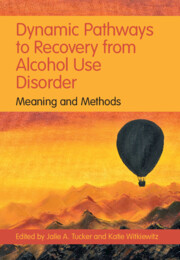Book contents
- Dynamic Pathways to Recovery from Alcohol Use Disorder
- Dynamic Pathways to Recovery from Alcohol Use Disorder
- Copyright page
- Dedication
- Contents
- Figures
- Tables
- Contributors
- Foreword
- Preface
- Acknowledgments
- Introduction
- Part I Micro Level
- Part II Meso Level
- 9 Natural Recovery from Alcohol Use Disorder
- 10 Individual Behavioral Interventions to Incentivize Sobriety and Enrich the Natural Environment with Appealing Alternatives to Drinking
- 11 Family and Social Processes in Recovery from Alcohol Use Disorder
- 12 Community-Based Harm Reduction Approaches for Alcohol Use Disorder
- 13 Use of Mobile Technology to Understand and Improve Recovery from Alcohol Use Disorder
- 14 Studying Recovery in the Social Context
- 15 Measuring Substance Use Contexts and Substance-Free Reinforcement
- Part III Macro Level
- Conclusions and Future Directions
- Index
- References
13 - Use of Mobile Technology to Understand and Improve Recovery from Alcohol Use Disorder
from Part II - Meso Level
Published online by Cambridge University Press: 23 December 2021
- Dynamic Pathways to Recovery from Alcohol Use Disorder
- Dynamic Pathways to Recovery from Alcohol Use Disorder
- Copyright page
- Dedication
- Contents
- Figures
- Tables
- Contributors
- Foreword
- Preface
- Acknowledgments
- Introduction
- Part I Micro Level
- Part II Meso Level
- 9 Natural Recovery from Alcohol Use Disorder
- 10 Individual Behavioral Interventions to Incentivize Sobriety and Enrich the Natural Environment with Appealing Alternatives to Drinking
- 11 Family and Social Processes in Recovery from Alcohol Use Disorder
- 12 Community-Based Harm Reduction Approaches for Alcohol Use Disorder
- 13 Use of Mobile Technology to Understand and Improve Recovery from Alcohol Use Disorder
- 14 Studying Recovery in the Social Context
- 15 Measuring Substance Use Contexts and Substance-Free Reinforcement
- Part III Macro Level
- Conclusions and Future Directions
- Index
- References
Summary
This chapter reviews how ubiquitous mobile technology can be used to better understand and improve recovery from alcohol use disorder. Distinct applications of both active and passive technology-assisted data collection (i.e., ecological momentary assessment, ambulatory assessment) to assess alcohol use and broader recovery outcomes are described. Previous studies of and future opportunities to use these methods to examine recovery-related processes and mechanisms of behavior change are highlighted. Promising mobile-based interventions or recovery support services examined to date are described, ranging from classic telehealth approaches to sophisticated interventions relying on both self-reported and sensor-based inputs to tailor the timing and content of intervention (i.e., ecological momentary interventions, Just-In-Time Adaptive Interventions). The chapter concludes with discussion of the potential for these interventions to achieve individualized intervention optimization (i.e., personalized treatment, precision medicine).
Keywords
- Type
- Chapter
- Information
- Dynamic Pathways to Recovery from Alcohol Use DisorderMeaning and Methods, pp. 239 - 259Publisher: Cambridge University PressPrint publication year: 2022



